Functional water quality
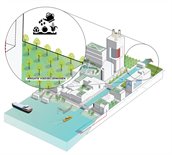
Irrigation of food crops relates to farmland, market gardens, picking gardens, and vegetable gardens. Urban areas accommodate few market gardens; food crops are mainly grown in picking gardens and vegetable gardens. Market gardens collect their own rainwater, but in times of drought this does not suffice, forcing them to use surface water and groundwater for irrigation purposes. Vegetable gardens probably also use surface water. The need for irrigation water is likely to increase as a result of climate change. Concurrently, the availability of suitable irrigation water may decrease, as climate change is exacerbating water quality issues. This can be attributed to two causes:
- During warm and dry periods, locally more blue-green algae may form in the water. Furthermore, the concentration of toxics such as pesticides and chemicals tends to increase, as periods of drought will obstruct their dilution.
- During torrential rain, larger quantities of pathogens will end up in the water, as a result of street run-off and sewer overflow. In addition, micro pollution will increase as the rainwater will carry pollutants such as tyre dust, copper and oil residue.
In low-lying parts of the Netherlands, the supply of suitable water will decline as a result of salinisation.
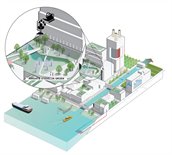
Irrigation water is also used for greenery other than food crops, such as ornamental gardens and public greenery. Climate change may push up the demand for such uses. First of all, because the weather will be increasingly warm and dry. Furthermore, municipalities are aiming for increased greening in the purview of biodiversity, CO2 reduction, and climate adaptation.
In the future, drought and deteriorating water quality may reduce the supply of sufficiently clean water. Cf. the description under Irrigation of food crops.
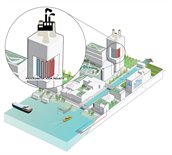
The industry uses surface water for purposes such as flushing and as process water. Climate change may lead to salinisation, e.g., as a result of saltwater seepage or the intake of brackish water. Salinisation may compromise the suitability of surface water for industrial purposes. This risk is run by industrial plants that cannot cope with high salt concentrations (chloride) in the water. If the chloride concentration rises too high, the water processing plants will need to use other materials, materials that are less prone to corrosion. In addition, other pre-treatments may be required. According to literature, such interventions may drive up production costs. No data is available on the actual critical salt content for the industry.
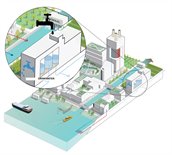
Sixty per cent of drinking water is sourced from groundwater, forty per cent comes from surface water. Drinking water is seldom sourced from urban surface water. Private parties have shown an interest in collecting drinking water from urban surface water, but we do not know if they will actually go through with this idea. In that case, salinisation and drought would pose particular risks for the use of drinking water:
- If chloride concentrations exceed 150 milligrams per litre as a result of salinisation, the water can no longer be used as drinking water.
- Drought reduces the dilution of pollutants in the water, as a result of which the concentration of, e.g., toxics may become too high.
In the future, such risks may lead to more drinking water intake stops.
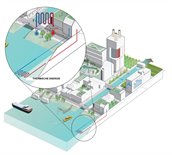
Surface water can also be used for heating or cooling. This is referred to as generating thermal energy from surface water. For example, surface water is used as industrial cooling water and for heating and cooling buildings.
Industrial cooling water
Cooling water accounts for the bulk of industrial water consumption. This water heats up during use and is subsequently discharged onto surface water. Climate change is expected to lead to more discharge restrictions. Furthermore, salinisation ensuing from climate change can limit the use of surface water as cooling water.
Why is climate change leading to more discharge restrictions?
Surface water must not become too warm, in order to protect fish and macro fauna (minute aquatic creatures) in the water. For that reason, during warm periods, when surface water automatically warms up, additional restrictions apply to the discharge of warm water. Such restrictions are expected to increase as a result of increasing heat and drought: heat causes the water to warm up more rapidly, whilst the flow rate of surface water decreases during periods of drought.
How do discharge restrictions affect the production of electricity?
According to a model study conducted by Van Vliet et.al. (2012), the capacity of nuclear and fossil power plants in Europe is expected to decrease by an average of 6.3% to 19% in the period 2031–2060. In that case, the probability of production decreasing by 90% or more will be three times as high. According to the Dutch National Adaptation Strategy (NAS), scarcity of cooling water (and/or a lack of wind) will drive up electricity prices at a European scale.
What is the impact of salinisation?
Salinisation of surface water can limit its use as cooling water. In the southwestern part of the Netherlands, salinisation can result in restrictions for 6% to 14% of the overall energy production, i.e., one to three power plants. Some plants are not affected by salinisation, and some have already been adapted to the use of (more) saline surface water.
Heating and cooling of buildings
Surface water can be used to heat and cool houses and other buildings. A heat exchanger transfers hot or cold water to the building’s climate system. For example, to heat a building in winter and provide hot tap water, heat can be extracted from surface water in summer and stored in the subsoil: thermal storage. To cool buildings, cold water can be extracted all year long from deep pools.
How does climate change affect options for thermal energy?
Water temperatures rise on account of more frequent warmer periods and higher temperatures, whilst in dry periods, (warm) water renovation decreases on account of lower flow rates. As yet, insufficient research has been conducted into such impacts. It is clear, however, that the volume of warm or cold water potentially to be collected will depend on three factors: the total water surface area, the water temperature, and the discharge (flow volume per second). Climate change affects the latter two factors. Thus, expectations are that climate change will have some impact on this functional use. The local-level impact can be examined in a model study.
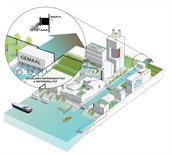
Climate change may affect the suitability of surface water in terms of its use to improve the water quality and quantity of another body of water.
Regulation of water quality
Surface water can be used to improve the quality of another body of water. For example, in some cases, additional water is let in to combat oxygen depletion. In some low-lying parts of the Netherlands, additional water is sometimes let in to combat salinisation. However, the inlet water must be of good quality. The quality of surface water may deteriorate as a result of climate change, which renders it unsuitable or less suitable as inlet water to be used to improve the quality of another body of water.
Regulation of water quantity: water intake
For various functional uses, such as housing and shipping, being able to keep up urban surface water levels is important. For example, excessively low water levels may damage the foundations of buildings, bridges, tunnels, and roads. Water levels can be regulated, e.g., by way of pumping stations, by supplying water from or discharging water to other locations. Climate change is facing us with more frequent periods of drought, which requires us to take in more water in order to keep up the water level. However, climate change can also lead to a deteriorating quality of inlet water. Inlet water of a quality worse than that of the receiving water may damage the ecology or compromise its suitability for other uses.
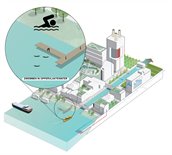
Climate change may deteriorate the quality of surface water to be used for swimming, resulting in increased health risks. Concurrently, such use of surface water is increasing. As temperatures are rising, more people will go for an outdoor swim. Not only at designated swimming locations, but also in, e.g., urban and rural canals, in many of which the water quality is not monitored. The quality of swimming water may deteriorate as a result of several climate effects:
- Run-off and sewer overflow following severe rain will lead to higher concentrations of pathogens in surface water. This will increase the risk of infectious diseases such as gastrointestinal issues and skin disorders. Higher water temperatures are known to increase the risk of swimmer’s itch, a disease caused by the larvae of the Trichobilharzia parasite, which occurs more frequently in higher water temperatures.
- High summer water temperatures are conducive to the occurrence of blue-green algae, which may result in a negative swimming advice.
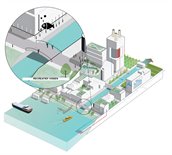
In urban areas, most fishing is for recreational purposes. As yet, no data is available on the impact of climate change on the appeal of urban surface water to amateur fishermen. Climate change is known, however, to affect the composition of fish species. For example, carp and bream are more resilient to a declining water quality. In addition, climate change may accelerate the growth of certain fish species and affect the fish spawning season. As a result, the fishing period for certain species may change. Furthermore, oxygen depletion of water due to high temperatures may cause fish mortality.
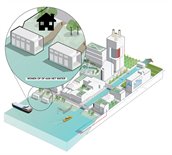
Among people living on or by the water, e.g., in a houseboat, climate change may affect their enjoyment of residence. For example, lower water levels may damage foundations and also sewer pipes. In addition, bad water quality can cause stench, blue-green algae, and midge issues.
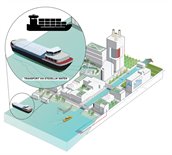
Urban water features in shipping routes for local, national, and international transport of goods and people. Freight transport by water is expected to increase in urban areas, as municipalities are pursuing increasingly more ambitions in the field of sustainability, whilst room on the roads is running out. According to the Dutch National Adaptation Strategy, climate change “is likely to result in restrictions for the shipping sector this century”, due to excessively low water levels during drought, excessively high levels during peak discharges, and limited discharge as a result of high seawater levels. Studies into the impact of climate change on the shipping sector are focused on the main inland shipping routes in Europe, particularly the river Rhine. No data is available regarding the impact on the possibilities for transport by water in urban areas.